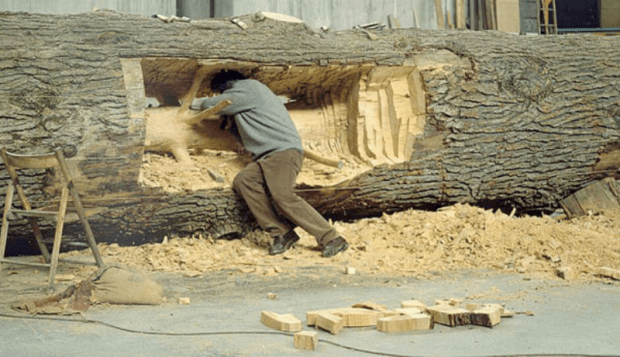Eventually,’ said Michelangelo Pistoletto, ‘it became a movement. In fact, I believe that arte povera was the last true movement. Since then all artists have been individuals.’ We were sitting one baking hot day last month in his cool study in Biella, a small town in the foothills of the Alps where he has established a huge museum and foundation in a series of disused 19th-century textile mills. He was discussing the group of Italian artists of the 1960s of which Pistoletto himself was a founding member.
Arte povera is an umbrella phrase that covers a number of diverse artists, several of them marvellous, who emerged in Italy about half a century ago. What they had in common was more a mood than a style exactly. Their work ran parallel to that being produced concurrently in many different places — by Richard Long in Britain, for example, and Joseph Beuys in Germany.
It often involved using real objects —rocks, cloth, pieces of metal — not to make images of other things by, say, carving marble into a human figure; nor even by making an abstraction — such as a geometric form. But using these materials just as themselves.
Thus, a stone might become part of a work of art about stones — their weight, the way that their surface has been eroded by time. This was an international tendency, but the artists of arte povera used it with, so to speak, an Italian inflection. They were aware of their predecessors going back into classical antiquity, and beyond, as I discovered when I talked to Pistoletto and his younger contemporary and fellow member of the group, Giuseppe Penone. This is modern art with roots (and, in the case of Penone, who likes to work with trees, sometimes leaves and branches as well).
The artists of arte povera are perhaps still less well known in this country than they deserve to be. This autumn, however, there is an excellent opportunity for the British audience to assess three of its leading members. Pistoletto himself has an exhibition at Blenheim Palace. Simultaneously, there is a wide-ranging selection of work by Penone at the Marian Goodman Gallery in Soho, and a display of early paintings by Jannis Kounellis at White Cube, Mason’s Yard.
Part of our British difficulty in comprehending arte povera is caused by the name itself. All collective names for coteries of artists — impressionism, cubism, rococo — are approximate and often originally employed by hostile critics. ‘Arte povera’ is not too inexact as these labels go, but it includes a trap for the non-native Italian speaker. The primary meaning of ‘povera’ is indeed ‘poor, needy’, but that was not what was intended. Here it is used in a secondary sense of ‘plain’, as in ‘plain style’. Or, as Pistoletto puts it, ‘It does not mean without money, it doesn’t mean miserable, it means without the superfluous, essential.’
This certainly applies to a series of works by Penone in which he took a length of commercial timber, neatly sawn into a beam, and carved part of it away to expose a slender trunk hidden within, with twigs sprouting from it. Thus he turned back time and revealed the sapling from which a big tree grew, long before it was felled and sawn into rectangular units to be stacked in a builder’s yard.
‘The best sculpture is one made by following the material, and understanding it,’ Penone told me. ‘The stupóre of the artist’ — that is, the wonder and amazement — lies in really seeing the material.’ This sense of the physical qualities of the stone, wood and the other substance he transforms into art links Penone to his Italian predecessors. ‘Bernini,’ he points out, ‘had a great feeling for the nature of the material, and he used them in a very sensual way.’
Penone’s huge studio in Turin is full of objects that also evoke that feeling. Quite a few are made from wood, including a massive bole of a forest giant, encrusted with bark, into which the artist has cut a sort of window through which you can see the tree’s graceful, younger self. This was displayed at Versailles three years ago, in a large exhibition throughout the formal gardens and the château.
Others pieces are made from bronze, leather and stone. Among those on show in London are slabs of marble, carefully carved to reveal the veins within the rocks, which stand out like the blood vessels of the human body or the contours of a landscape threaded by valleys and streams.
For all the radical appearance of their works, the arte povera group shared a surprisingly strong sense of history. In the 1950s, when Pistoletto was starting out as a painter, abstraction was all the rage. ‘People said, if it’s figurative it’s old, if it’s abstract it’s modern. I didn’t accept that idea, it was not part of my culture. Italian art has been figurative from the beginning: Greek, Roman, Renaissance, Baroque. It’s always based on a figure.’
Over the years, he has quoted works from that lineage. One of his most celebrated pieces, ‘Venere degli stracci’ or ‘Venus of the Rags’
Michelangelo Pistoletto at Blenheim Palace is on view until 31 December. More details can be found here.






Comments